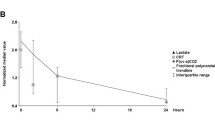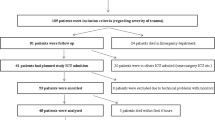Abstract
The most common condition that brings patients to the medical intensive care unit (MICU) is hemodynamic instability, accompanied by tissue hypoperfusion. In order to make easier and quicker diagnosis of this syndrome marker tissue hypoperfusion is monitored. The aim of this study is to determine the prognostic significance of the level of lactate, lactate clearance, central venous oxygen saturation (ScvO2) and venous-to-arterial carbon dioxide difference (∆pCO2) in two time periods in critically ill patients with acute circulatory failure in low income countries. This is a prospective study for a period of 8 months that included all patients with signs of cardiovascular system failure and tissue hypoperfusion. The study included 82 patients with the mean age of 64 years, of which 37% were women. The values of the lactate in surviving patients who had some form of non-septic shock at the zero hour (T0) were T0 = 6.31 ± 5.15, and at the sixth hour after reanimation the values (T6) were T6 = 3.71 ± 3.62 (p < 0.05), while the lactate levels in the group of non-survivors were T0 = 6.64 ± 7.55 and T6 = 9.41 ± 9.51; (p > 0.05). The main conclusion of this study is that the serum lactate concentration in patients who developed some form of non-septic shock has the highest predictive significance compared to the other two markers of tissue hypoperfusion (venous-to-arterial carbon dioxide difference and central venous oxygen saturation).
Zusammenfassung
Die häufigste Erkrankung, welche eine Versorgung der Patienten auf der Intensivstation erforderlich macht, ist die hämodynamische Instabilität, begleitet von einer Gewebehypoperfusion. Um einfacher und schneller zur Diagnose dieses Syndroms zu gelangen, wird der Marker für Gewebehypoperfusion kontrolliert. Das Ziel dieser Studie ist die Bestimmung der prognostischen Signifikanz der Laktatkonzentration, Laktat-Clearance, zentralvenösen Sauerstoffsättigung (ScvO2) und der arteriovenösen Kohlendioxid-Differenz (∆pCO2) in zwei Zeiträumen bei kritisch kranken Patienten mit akutem Kreislaufversagen in Ländern mit geringem Einkommen. Es handelt sich hierbei um eine prospektive Studie über einen Zeitraum von 8 Monaten, in die alle Patienten mit Zeichen eines Herz-Kreislauf-Versagens und Gewebehypoperfusion eingeschlossen wurden. Insgesamt wurden 82 Patienten mit einem mittleren Alter von 64 Jahren in die Studie eingeschlossen, von denen 37 % weiblich waren. Die Laktatwerte bei überlebenden Patienten, die zum Zeitpunkt 0 (T0) eine Form nichtseptischen Schocks erlitten hatten, betrugen T0 = 6,31 ± 5,15. Sechs Stunden nach Reanimation (T6) lagen die Laktatwerte bei T6 = 3,71 ± 3,62 (p < 0,05), während sie in der Gruppe der Nichtüberlebenden T0 = 6,64 ± 7,55 sowie T6 = 9,41 ± 9,51; (p > 0,05) betrugen. Die wichtigste Schlussfolgerung dieser Studie ist, dass die Serumlaktatkonzentration bei Patienten, die eine Form nichtseptischen Schocks erlitten hatten, im Vergleich zu den anderen beiden Markern für Gewebehypoperfusion (arteriovenöse Kohlendioxid-Differenz und zentralvenöse Sauerstoffsättigung) die höchste prädiktive Signifikanz hatten.
Similar content being viewed by others
Abbreviations
- ∆pCO2 :
-
Venous-to-arterial carbon dioxide differences
- FiO2:
-
Fraction of inspired oxygen
- MAP:
-
Mean arterial pressure
- MICU:
-
Medical intensive care unit
- PEEP:
-
Positive end-expiratory pressure
- SAPS II Score:
-
Simplified Acute Physiology Score
- ScvO2 :
-
Central venous oxygen saturation
- SOFA Score:
-
Sequential Organ Failure Assessment
- UN:
-
United Nations
- WHO:
-
World Health Organization
References
Molina JAD, Seow E, Heng BH et al (2014) Outcomes of direct and indirect medical intensive care unit admissions from the emergency department of an acute care hospital: a retrospective cohort study. BMJ Open 4:e5553. https://doi.org/10.1136/bmjopen-2014-005553
Singer M, Deutschman CS, Seymour CW, Shankar-Hari M, Annane D, Bauer M et al (2016) The third international consensus defnitions for sepsis and septic shock (sepsis-3). JAMA 315:801–810
GBD 2015 Mortality and Causes of Death Collaborators (2016) Global, regional, and national life expectancy, all-cause mortality, and cause-specific mortality for 249 causes of death, 1980–2015: a systematic analysis for the Global Burden of Disease Study 2015. Lancet 388:1459–1544
Kashyap R, Hache-Marliere M, Gavrilovic S, Gajic O (2015) Improving outcomes for the critically ill in developing countries: what is next? Rev Bras Ter Intensiva 27:312–314
Reinhart K, Daniels R, Kissoon N et al (2017) Recognizing sepsis as a global health priority—a WHO resolution. N Engl J Med 377:314–317
Dellinger RP, Levy MM, Rhodes A et al (2013) Surviving Sepsis Campaign: international guidelines for management of severe sepsis and septic shock, 2012. Intensive Care Med 39:165–228
Rhodes A, Evans LE, Alhazzani W et al (2017) Surviving Sepsis Campaign: International guidelines for management of sepsis and septic shock: 2016. Crit Care Med 45:486–552
Vukoja M, Riviello ED, Schultz MJ (2018) Critical care outcomes in resource-limited settings. Curr Opin Crit Care 24(5):421–427
Thiéry G, Kovacević P, Straus S, Vidovic J, Iglica A, Festic E, Gajic O (2009) From mechanical ventilation to intensive care medicine: a challenge for Bosnia and Herzegovina. Bosn J Basic Med Sci 9(Suppl 1):69–76
Murthy S, Leligdowicz A, Adhikari NKJ (2015) Intensive care unit capacity in low-income countries: a systematic review. PLoS ONE 10:e116949. https://doi.org/10.1371/journal.pone.0116949
Hasanin AMukhtar A, Nassar H (2017) Perfusion indices revisited. J Intensive Care 5:24
Antonelli M, Levy M, Andrews PJ et al (2007) Hemodynamic monitoring in shock and implications for management. Intensive Care Med 33(4):575–590
Kruse O, Grunnet N, Barfod C (2011) Blood lactate asa predictor for in-hospital mortality in patients admitted acutely to hospital: a systematic review. Scand J Trauma Resusc Emerg Med 19:74
Verhaeghe M, Hachimi-Idrissi S (2018) Blood lactate and lactate kinetics as treatment and prognosis markers for tissue hypoperfusion. Acta Clin 28:1–8
Ducrocq N, Kimmoun A, Levy B (2013) Lactate or ScvO2 asan endpoint in resuscitation of shock states? Minerva Anestesiol 79(9):1049–1058
Hisamuddin NA, Azlan K (2012) The use of laboratory andphysiological parameters in predicting mortality insepsis induced hypotension and septic shock patientsattending the emergency department. Med J Malaysia 67(3):259–264
Thomas-Rueddel DO, Poidinger B, Weiss M et al (2015) Hyperlactatemia is an independent predictor of mortality and denotes distinct subtypes of severe sepsisand septic shock. J Crit Care 30(2):439e1–439e6
Trzeciak S, Dellinger RP, Chansky ME et al (2007) Serumlactate as a predictor of mortality in patients withinfection. Intensive Care Med 33(6):970–977
Howell MD, Donnino M, Clardy P et al (2007) Occult hypoperfusion and mortality in patients with suspectedinfection. Intensive Care Med 33(11):1892–1899
Marty P, Roquilly A, Vallée F, Luzi A, Ferré F, Fourcade O, Asehnoune K, Minville V (2013) Lactate clearance for death prediction in severe sepsis or septic shock patients during the first 24 hours in Intensive Care Unit: an observational study. Ann Intensive Care 3(1):3
Filho RR, Rocha LL, Corrêa TD, Pessoa CM, Colombo G, Assuncao MS (2016) Blood lactate levels cutoff and mortality prediction in sepsistime fora reappraisal? aretrospective cohort study. Shock 46(5):480–485
Attaná P, Lazzeri C, Chiostri M, Picariello C, Gensini GF, Valente S (2012) Lactate clearance in cardiogenic shock following ST elevation myocardial infarction: a pilot study. Acute Card Care 14(1):20–26
DiaztagleFernández JJ, Rodríguez Murcia JC, SprockelDíaz JJ (2017) Venous-to-arterial carbon dioxide difference inthe resuscitation of patients with severe sepsisand septic shock: A systematic review. Med Intensiva 41(7):401–410
Pan J, Peng M, Liao C, Hu X, Wang A, Li X (2019) Relative efficacy and safety of early lactate clearance guided therapy resuscitation in patientswith sepsis: a meta-analysis. Medicine (Baltimore) 98:e14453
Kubiak GM, Tomasik AR, Bartus K, Olszanecki R, Ceranowicz P (2018) Lactate in cardiogenic shock—current understanding and clinical implications. J Physiol Pharmacol 69:15–21
Author information
Authors and Affiliations
Corresponding author
Ethics declarations
Conflict of interest
D. Momcicevic, T. Kovacevic, S. Dragic, J. Cavka and P. Kovacevic declare that they have no competing interests.
All procedures performed in studies involving human participants or on human tissue were in accordance with the ethical standards of the institutional and/or national research committee and with the 1975 Helsinki declaration and its later amendments or comparable ethical standards. Informed consent was obtained from all individual participants included in the study.
Ethical approval and informed consent
The study was approved by the Ethics Committee of the University Clinical Center of the Republic of Srpska. The informed consent was signed by the authorized representative of the patients.
Additional information
Redaktion
M. Buerke, Siegen
Rights and permissions
About this article
Cite this article
Momcicevic, D., Kovacevic, T., Dragic, S. et al. Predictive significance of tissue hypoperfusion markers in different shock types in low income countries. Med Klin Intensivmed Notfmed 115, 307–311 (2020). https://doi.org/10.1007/s00063-019-0592-5
Received:
Accepted:
Published:
Issue Date:
DOI: https://doi.org/10.1007/s00063-019-0592-5
Keywords
- Shock
- Lactate
- Venous-to-arterial carbon dioxide difference
- Central venous oxygen saturation
- Fatal outcome




